|
|

Handbook on Viewing Buddhist Statues
A totally wonderful
book by Ishii Ayako.
Some images
at this site were
scanned from this
book; Japanese
language only;
192 pages;
80+ color photos
Click here to
buy book at Amazon
|
|

Kōmokuten 広目天
King of the West, Lord of Limitless Vision. Sees through Evil
Associations = West, Fall, Metal, Awareness, White
ORIGIN = Hindu deity incorporated into Buddhism.
Member of the TENBU, SHITENNŌ, DEVA
One of Four Heavenly Kings Who Guard East, West, North, South
Governed by Taishakuten (Skt. = Indra), Lord of the Center
|
Japanese Mantra
おん びろばくしゃ のうぎゃ
ぢはたえい そわか
On Birobakusha Nōgya Chihataei Sowaka
(or)
Om Birobakusha Nōgya Chihataei Sowaka
|
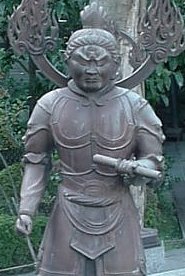
Kōmokuten at Hase Dera, Kamakura.
Modern, Metal. Click image to enlarge.
|

Sanskrit Seed
for Kōmokuten
Pronounced
BI in Japan
|
|
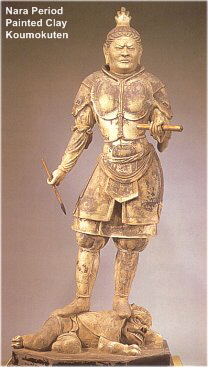
Kōmokuten 広目天
Painted Clay, H = 162.7 cm, 8th Century
Tōdaiji (Todaij) Temple 東大寺, Nara
|
|
 Kōmokuten 広目天 literally means Wide Eyed or Expansive Vision. Kōmokuten sees through evil, punishes evil, and encourages aspirations for enlightenment. Kōmokuten is one of the four Shintennō, a group of fierce-looking (忿怒相 funnusō) guardian deities who protect the four cardinal directions of Buddha’s realm. In artwork, the four are typically placed around the central deity on Buddhist altars. Kōmokuten protects the western quarter. Like the other members of the Shintennō group, Kōmokuten is typically dressed in armor (yoroi 鎧) and stands atop a demon (jaki 邪鬼). The oldest statue of Komokuten in Japan (see photo at right) dates to the middle 7th century and is located at Hōryūji Temple 法隆寺 in Nara. It is part of an extant set of all four.
In mainland Asia, Komokuten is often shown with red skin holding a jewel in one hand and a snake in the other or coiled around the deity. Komokuten is attended by the Naga (Sanskrit for serpents, including dragons) and the Pūtanā (type of hungry ghost associated with fevers and protecting pregnant women; in Vedic traditions a demon witch who killed babies). Komokuten is the Buddhist equivalent to the white tiger of Chinese mythology, in which four creatures (dragon, tiger, red bird, turtle) guard the four cardinal directions. In China, Komokuten is called Guangmu, in Tibet Mig Midang. (Editor’s note: The color associated with Komokuten varies and does not appear to be rigidly set).
|
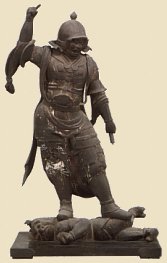
Kōmokuten
Wood, H = 110 cm.
Heian Era, 11 Century
Hōryūji Temple 法隆寺 in Nara
Photo: Temple catalog
|
|
 VARIOUS SPELLINGS & ASSOCIATIONS VARIOUS SPELLINGS & ASSOCIATIONS
- Japanese = Kōmokuten, Komokuten, Koumokuten 広目天
- Sanskrit = Virūpākṣa, Virupaksa, Virupaksha
- Chinese = Guǎngmùtiān, Kuang-mu-t'ien
- Korean = 광목천, Gwangmokcheon, Kwangmokch'ŏn
- Vietnam = Quảng mục thiên
- Kōmokuten literally means “Wide Eyed” or “Expansive Vision.”
- King of the West, Sees through evil. Discerns / punishes badness. Lord of Limitless Vision. Encourages aspirations for enlightenment.
- West, Fall, Metal, Awareness, White (Red in India & China)
- Dwells in and protects the western continent Saigokashū 西牛貨洲 (Skt. = Aparagodāna) surrounding Mt. Shumisen 須弥山 (Skt. = Mt. Sumeru). This mountain is the mythical home of the Historical Buddha and other Buddhist deities).
- Rules over the Nāga 龍 (serpent-like demigods, including dragons)
- Rules over the Pūtana 富單那, a type of hungry ghost associated with fevers and with causing sickness among children. In Vedic traditions, Pūtana is a demon witch who kills babies. <source Digital Dictionary of Chinese Buddhism>.
- Appears in the western portion of the Gekongōbu-in 外金剛部院. (outer section) of the Taizōkai Mandala 胎蔵界曼荼羅 (Womb World, Matrix Realm).
- Appears in various other mandala, including the Ten Realms Mandala and Hōrōkaku Mandala.
- In the Nichiren sects, Kōmōkuten is #33 on the Gohonzon 御本尊 diagram.
- Nearly always dressed in armor (yoroi 鎧), looking ferocious (funnusō 忿怒相), and carrying weapons or objects (jimotsu 持物) said to eliminate evil influences and suppress the enemies of Buddhism. Also typically shown standing atop evil spirits (known as Jaki in Japan), symbolizing the power to repel and defeat evil. Sometimes depicted with a fiery halo.
- Often depicted holding a writing brush in right hand and a sutra in left (symbolizing the power of Buddha’s teachings to overcome ignorance, evil, and all obstacles), or clenching the right fist while the left holds a three-pronged spear (sansageki 三叉戟); however, the deity’s attributes are not rigidly prescribed and thus differ among Buddhist nations.
- Oldest extant statue of Kōmokuten is part of a set of four Shitennō statues possessed by Hōryūji Temple 法隆寺 in Nara that dates to the mid-7th Century. See photo below.

|
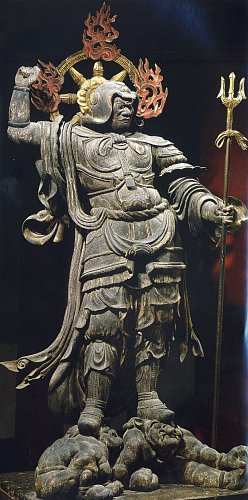
Kōmokuten 広目天
Toji (Tōji) Temple 東寺, Kyoto
Heian Era, 839 AD, H = 171.8 cm, Painted Wood
Photo Source = 日本の仏像 Vol. 4
|
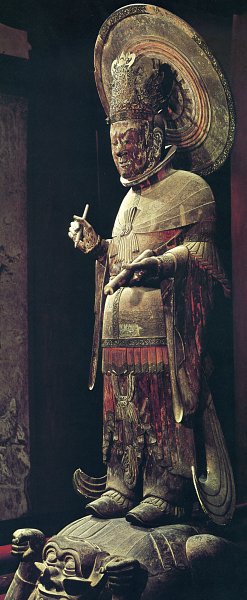
Kōmokuten 広目天
Oldest extant image of Kōmokuten in Japan
Wood, H = 133.3 cm, Mid-7th Century
Hōryūji Temple 法隆寺 in Nara, Carved by Yamaguchi Busshi
Photo: Comprehensive Dictionary of Japan's Nat’l Treasures
国宝大事典 (西川 杏太郎). ISBN 4-06-187822-0.
|
|
|
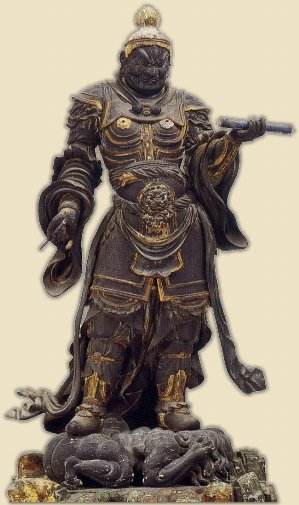
Kōmokuten 広目天, H = 135.2 cm
Dated to early Kamakura era, 13th century
Mt. Kōya 高野山, Kongōbuji Temple 金剛峰寺
Originally located at Todaiji (Tōdaiji) Temple 東大寺
Photo Source = 日本の仏像 Vol. 10
|
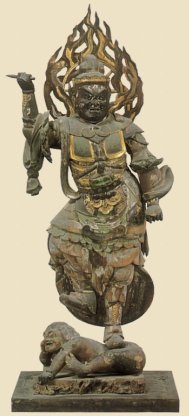
Kōmokuten (Virupaksa)
H = 94 cm, Wood with Pigments
Heian Era 12th Century
Hōryūji Temple 法隆寺 in Nara
|
|

JYAKI (JAKI) DEMON - 邪鬼
In Japan, the Four Shitennō Guardians are almost always shown stepping on evil demons called Jyaki or Tentōki. This iconography symbolizes the power of the Shitennō to repel and defeat evil.
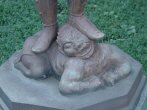 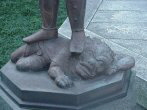 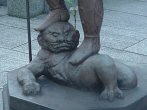
Jaki (Jyaki) at Hase Dera in Kamakura (click any image to enlarge)
Click here for more details about the Jyaki demons.

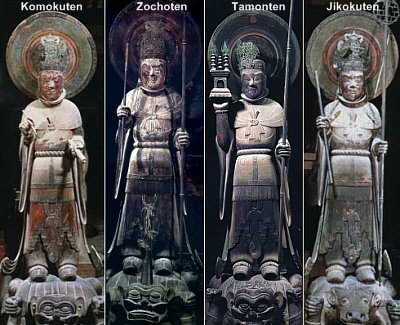
Four Shitenno, Horyuji (Hōryūji) Temple 法隆寺, Nara
Mid-7th Century. Oldest extant set of the four.
Kōmokuten 広目天, Zōchōten 増長天, Tamonten 多門天, Jikokuten 持国天
Painted Wood, Each Statue Approx. 133.5 cm in Height
Photos from Comprehensive Dictionary of Japan's Nat’l Treasures
国宝大事典 (西川 杏太郎. ISBN 4-06-187822-0.

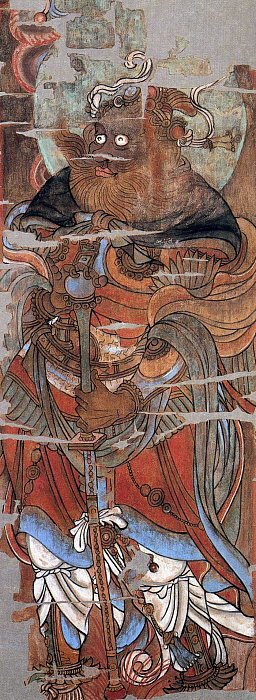
Kōmokuten (West). Chinese = Guǎngmùtiān
Tang Dynasty, 9th Century. Ink and colors on silk.
H = 43.5 cm, W = 18 cm. British Museum, Stein Painting 137.
Painting from the Hidden Library Cave, Dunhuang, China
Scanned from DUNHUANG: A Centennial Commemoration of the Discovery of the Cave Library.
ISBN 7-5054-0716-3/J-0396. First published in 2000 by Morning Glory Publishers, Beijing, China
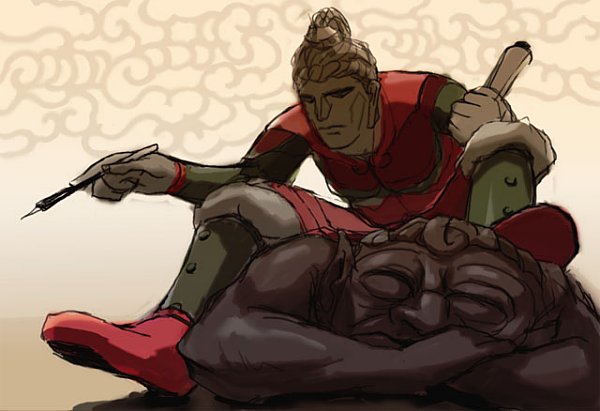
Kōmokuten (West) holding his customary writing brush and sutra and sitting atop the evil Jyaki.
Image from Deadly Towers, a modern video game. Photo courtesy: http://www.deadlytowers.com/

LEARN MORE
- Buddhist-Artwork.com, our sister estore, offers statues of the Shitennō.
- Shitennō, Four Heavenly Kings. Four Deva Kings. Guardians of East, West, North, South (the four cardinal directions). The Shitennō are also associated with four legendary creatures of Chinese mythology (dragon, red bird, tiger, turtle). See Shijin (Four Celestial Emblems) for more on these four creatures.
- In the Japanese Mandala, the Shitennō (Guardians of the Four Directions) are typically shown, from the top, starting with the eastern guardian. Thus, the typical order is Jikokuten (East), Zōchōten (South), Kōmokuten (West), and Tamonten (North).
- 28 Constellations, 28 Moon Lodges, 28 Moon Stations (this site)
Learn more about each of the four quarters (north, south, east, west) and the seven constellations in each group. All 28 represent points in the moon’s monthly path, and each was deified.
- Butsuzō-zu-i 仏像図彙, the “Collected Illustrations of Buddhist Images.” Published in 1690. One of Japan’s first major studies of Buddhist iconography. Hundreds of pages and drawings, with deities classified into approximately 80 (eighty) categories. Modern-day reprints of the expanded Meiji-era version are available at this online store (J-site).
- Mandara Zuten 曼荼羅図典 (Japanese Edition). The Mandala Dictionary. 422 pages. First published in 1993. Publisher Daihorinkaku 大法輪閣. Language Japanese. ISBN-10: 480461102-9. Available at Amazon.
- JAANUS. Japanese Architecture & Art Net Users System. Compiled by the late Dr. Mary Neighbour Parent; covers both Buddhist and Shintō deities in great detail and contains over 8,000 entries.
- A Dictionary of Chinese Buddhist Terms. With Sanskrit & English Equivalents. Plus Sanskrit-Pali Index. By William Edward Soothill & Lewis Hodous. Hardcover, 530 pages. Published by Munshirm Manoharlal. Reprinted March 31, 2005. ISBN 8121511453.
- Digital Dictionary of Chinese Buddhism (C. Muller; login "guest")
- Buddhism: Flammarion Iconographic Guides, by Louis Frederic, Printed in France, ISBN 2-08013-558-9, First published 1995.
- 4 Heavenly Kings, Great Mandala Study Group (outside link). Also see Four Heavenly Kings, Nichiren Tradition (outside link). “They appear in the ceremony of the Lotus Sutra with their 10,000 retainer gods in the Dharani (26th chapter). Therein, Jikokuten and Bishamonten pledge on behalf of all four to protect those who embrace the Lotus Sutra.
- Four Heavenly Kings (J-site, outside link), plus Sanskrit characters used herein.
- See Bibliography for our complete list of resources on Japanese Buddhism.

|
|